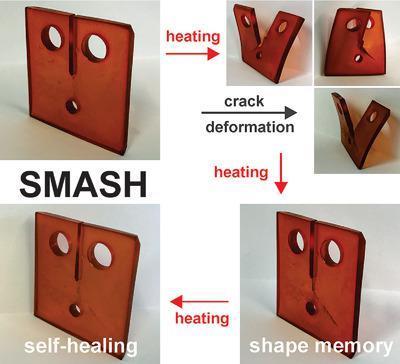当前位置:
X-MOL 学术
›
Macromol. Mater. Eng.
›
论文详情
Our official English website, www.x-mol.net, welcomes your
feedback! (Note: you will need to create a separate account there.)
Thermally Assisted Self‐Healing and Shape Memory Behavior of Diphenolic Acid‐Based Benzoxazines
Macromolecular Materials and Engineering ( IF 4.2 ) Pub Date : 2020-10-12 , DOI: 10.1002/mame.202000463 Aleš Ručigaj 1 , Rok Ambrožič 1 , Matjaž Krajnc 1
Macromolecular Materials and Engineering ( IF 4.2 ) Pub Date : 2020-10-12 , DOI: 10.1002/mame.202000463 Aleš Ručigaj 1 , Rok Ambrožič 1 , Matjaž Krajnc 1
Affiliation

|
Two diphenolic acid‐based benzoxazines are designed and crosslinked to form smart polymers with shape memory and self‐healing ability. Aliphatic molecules of stearylamine and jeffamine are selected with the intent to introduce network flexibility and mobility in the designed copolymer system. While stearylamine is incorporated to form a more rigid benzoxazine molecule (DaSa), aliphatic polyether molecule of jeffamine in benzoxazine (DaJa) allows system mobility. Prepared benzoxazine precursors are characterized by nuclear magnetic resonance and IR method, while thermomechanical properties are determined by differential scanning calorimetry and dynamic mechanical analysis. Glass transition temperature increases with the increasing proportion of the more rigid benzoxazine from stearylamine ranging from 6 to 104 °C. All prepared copolymers show promising self‐healing and shape memory abilities proved by fracture toughness and self‐deploy tests, respectively. The best results are reached at 50 and 60 wt% of DaSa benzoxazine (glass transition temperature being 83 and 84 °C) in the copolymer system with self‐healing ability of 50–60% in three consecutive cycles, shape fixity above 90%, and shape recovery over 90%. The synthesis chemicals such as diphenolic acid, jeffamine, stearylamine, and paraformaldehyde can be of a natural origin having a great potential to develop a bio‐based system.
中文翻译:

基于二酚酸的苯并恶嗪的热辅助自修复和形状记忆行为
设计并交联了两种基于二酚酸的苯并恶嗪,以形成具有形状记忆和自我修复能力的智能聚合物。选择硬脂胺和杰夫胺的脂族分子是为了在设计的共聚物体系中引入网络柔性和流动性。当引入硬脂胺以形成更刚性的苯并恶嗪分子(DaSa)时,苯并恶嗪(DaJa)中的jeffamine脂族聚醚分子允许系统迁移。制备的苯并恶嗪前体通过核磁共振和红外方法表征,而热机械性能通过差示扫描量热法和动态力学分析确定。玻璃化转变温度随硬脂胺中刚性更高的苯并恶嗪的比例在6至104°C之间而增加。所有制备的共聚物均显示出令人满意的自我修复和形状记忆能力,分别通过断裂韧性和自我展开测试证明。在共聚物体系中,DaSa苯并恶嗪的含量为50和60 wt%(玻璃化转变温度分别为83和84°C)时,在连续三个循环中具有50–60%的自愈能力,形状固定性超过90%,形状恢复率超过90%。合成化学物质(例如二酚酸,杰夫胺,硬脂胺和多聚甲醛)可能是天然来源的,具有开发生物基系统的巨大潜力。在共聚物体系中,DaSa苯并恶嗪的含量为50和60 wt%(玻璃化转变温度分别为83和84°C)时,在连续三个循环中具有50–60%的自愈能力,形状固定性超过90%,形状恢复率超过90%。合成化学物质(例如二酚酸,杰夫胺,硬脂胺和多聚甲醛)可能是天然来源的,具有开发生物基系统的巨大潜力。在共聚物体系中,DaSa苯并恶嗪的含量为50和60 wt%(玻璃化转变温度分别为83和84°C)时,在连续三个循环中具有50–60%的自愈能力,形状固定性超过90%,形状恢复率超过90%。合成化学物质(例如二酚酸,杰夫胺,硬脂胺和多聚甲醛)可能是天然来源的,具有开发生物基系统的巨大潜力。
更新日期:2020-12-15
中文翻译:

基于二酚酸的苯并恶嗪的热辅助自修复和形状记忆行为
设计并交联了两种基于二酚酸的苯并恶嗪,以形成具有形状记忆和自我修复能力的智能聚合物。选择硬脂胺和杰夫胺的脂族分子是为了在设计的共聚物体系中引入网络柔性和流动性。当引入硬脂胺以形成更刚性的苯并恶嗪分子(DaSa)时,苯并恶嗪(DaJa)中的jeffamine脂族聚醚分子允许系统迁移。制备的苯并恶嗪前体通过核磁共振和红外方法表征,而热机械性能通过差示扫描量热法和动态力学分析确定。玻璃化转变温度随硬脂胺中刚性更高的苯并恶嗪的比例在6至104°C之间而增加。所有制备的共聚物均显示出令人满意的自我修复和形状记忆能力,分别通过断裂韧性和自我展开测试证明。在共聚物体系中,DaSa苯并恶嗪的含量为50和60 wt%(玻璃化转变温度分别为83和84°C)时,在连续三个循环中具有50–60%的自愈能力,形状固定性超过90%,形状恢复率超过90%。合成化学物质(例如二酚酸,杰夫胺,硬脂胺和多聚甲醛)可能是天然来源的,具有开发生物基系统的巨大潜力。在共聚物体系中,DaSa苯并恶嗪的含量为50和60 wt%(玻璃化转变温度分别为83和84°C)时,在连续三个循环中具有50–60%的自愈能力,形状固定性超过90%,形状恢复率超过90%。合成化学物质(例如二酚酸,杰夫胺,硬脂胺和多聚甲醛)可能是天然来源的,具有开发生物基系统的巨大潜力。在共聚物体系中,DaSa苯并恶嗪的含量为50和60 wt%(玻璃化转变温度分别为83和84°C)时,在连续三个循环中具有50–60%的自愈能力,形状固定性超过90%,形状恢复率超过90%。合成化学物质(例如二酚酸,杰夫胺,硬脂胺和多聚甲醛)可能是天然来源的,具有开发生物基系统的巨大潜力。











































 京公网安备 11010802027423号
京公网安备 11010802027423号